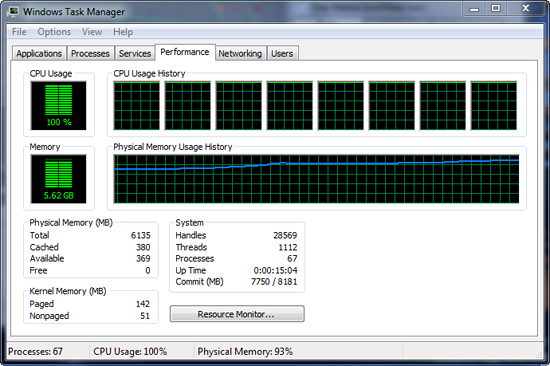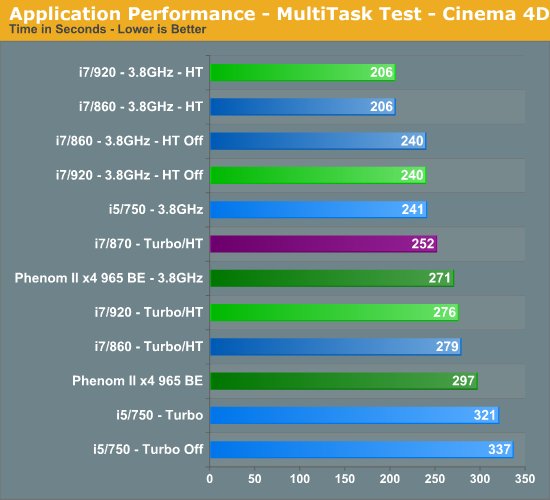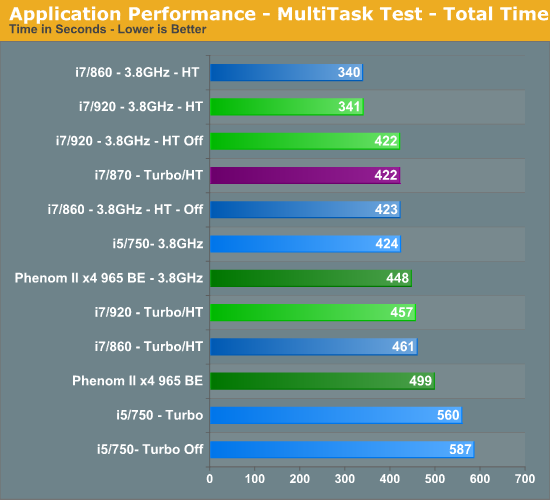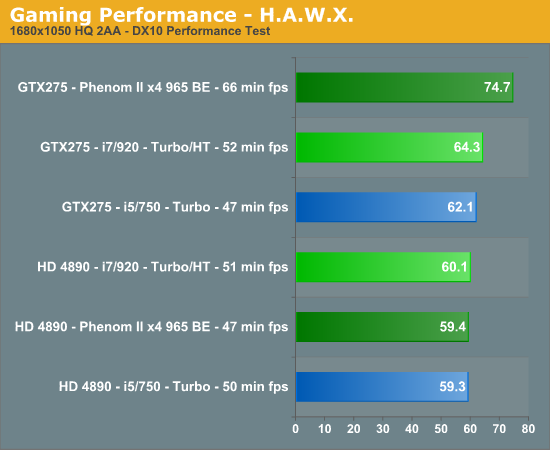i5 / P55 Lab Update - Now with more numbers
by Gary Key on September 15, 2009 12:05 AM EST- Posted in
- Motherboards
Multitasking-
The vast majority of our benchmarks are single task events that utilize anywhere from 23MB up to 1.4GB of memory space during the course of the benchmark. Obviously, this is not enough to fully stress test our 6GB or 8GB memory configurations. We devised a benchmark that would simulate a typical home workstation and consume as much of the 6GB/8GB as possible without crashing the machine.
We start by opening two instances of Internet Explorer 8.0 each with six tabs opened to flash intensive websites followed by Adobe Reader 9.1 with a rather large PDF document open, and iTunes 8 blaring the music selection of the day loudly. We then open two instances of Lightwave 3D 9.6 with our standard animation, Cinema 4D R11 with the benchmark scene, Microsoft Excel and Word 2007 with large documents, and finally Photoshop CS4 x64 with our test image.

Before we start the benchmark process, our idle state memory usage is 4.05GB. Sa-weet!

We wait two minutes for system activities to idle and then start playing Pinball Wizard via iTunes, start the render scene process in Cinema 4D R11, start a resize of our Photoshop image, and finally the render frame benchmark in Lightwave 3D. Our maximum memory usage during the benchmark is 5.62GB with 100% CPU utilization across all four or eight threads.



So far, our results have pretty much been a shampoo, rinse, and repeat event. I believe multitasking is what separates good systems from the not so good systems. I spend very little time using my system for gaming and when I do game, everything else is shutdown to maximize frame rates. Otherwise, I usually have a dozen or so browser windows open, music playing, several IM programs open and in use, Office apps, and various video/audio applications open in the background.
One or two of those primary applications are normally doing something simultaneously, especially when working. As such, I usually find this scenario to be one of the most demanding on a computer that is actually utilized for something besides trying to get a few benchmark sprints run before the LN2 pot goes dry.
The i5/750 results actually surprised me. The system never once felt “slow” but the results do not lie. The i5/750 had its head served on a platter at stock speeds, primarily due to the lack of Hyper-Threading when compared to the other choices. The 965 BE put up very respectable numbers and scaled linearly based on clock speed. An 11% increase in clock speed resulted in a 10% improvement in the total benchmark score for the 965 BE. You cannot ask for more than that.
At 3.8GHz clock speeds, it is once again a tossup between the 920 and 860 processors with HT enabled. The 920 did hold a slight advantage over the 860 at stock clock settings, attributable to slightly better data throughput when under load conditions. Otherwise, on the Intel side the i7/870 provided excellent results based on its aggressive turbo mode, although at a price.
Gaming-
We utilize the Ranch Small demo file along with the FarCry 2 benchmark utility. This particular demo offers a balance of both GPU and CPU performance.

We utilize FRAPS to capture our results in a very repeatable section of the game and report the median score of our five benchmark runs. H.A.W.X. responds well to memory bandwidth improvements and scales linearly with CPU and GPU clock increases.

Your eyes are not deceiving you. After 100+ clean OS installs, countless video card, motherboard, memory and driver combinations, we have results that are not only repeatable, but appear to be valid. We also tracked in-game performance with FRAPS and had similar results. Put simply, unless we have something odd going on with driver optimizations, a BIOS bug, or a glitch in the OS, our NV cards perform better on the AMD platform than they do on the Intel platform. The pattern reverses itself when we utilize the AMD video cards.
It is items like this that make you lose hair and delay articles. Neither of which I can afford to have happen. However, we have several suppliers assisting us with the problem (if it is a problem) and hope to have an answer shortly. These results also repeat themselves in other games like H.A.W.X. and Left 4 Dead but not in Crysis Warhead or Dawn of War II. So, besides the gaming situation, we also see a similar pattern in AutoCad 2010 and other 3D rendering applications where GPU acceleration is utilized, it is just not as pronounced.










77 Comments
View All Comments
glenster - Wednesday, September 16, 2009 - link
Another consideration for comparison is that the Core i7 960 3.2GHz is due Q4 2009 for $562--see Wikipedia > Nehalem > 45 nm processor architecture. Another site says it's due Oct.18.grimpr - Tuesday, September 15, 2009 - link
Its always fun to watch cases of reversal...in this case, that the AMD/Nvidia combination is proven superior to the gamers and the oems market favorite Intel/Nvidia combo. We can sense the suspicions, fear and doubt on Garys comments and we wait more from him for our further enjoyment. Gary, keep on the Intel crusade...Gary Key - Tuesday, September 15, 2009 - link
There is no fear or doubt, just a quest to figure out why there is such a difference between the NV and AMD GPUs on each platform. If you are an Intel crusader I guess your suspicions would lead you to believe that NV is dogging performance on the Intel platforms.If you are an AMD crusader, you would think AMD is dogging performance on their own platform. Think about that for a moment. I seriously doubt either company is dogging it as they both depend heavily on GPU sales for their survival.
Please read this and just about any other article I have written on AMD and tell me if you really believe I am on an Intel crusade - http://www.anandtech.com/mb/showdoc.aspx?i=3506">http://www.anandtech.com/mb/showdoc.aspx?i=3506 . ;) I care about the best possible performance for the best possible price, with a dash of support thrown in. No hidden agendas around here and if you think so, you would be wrong.
yacoub - Tuesday, September 15, 2009 - link
The rest of us know it's not the case, Gary, but the trolls are just tossing out bait to get you to bite. Ignore 'em.lopri - Wednesday, September 16, 2009 - link
For real. If the test was done using dual-channel on X58 there'd be a huge outrage from certain users how X58 was arbitrarily disadvantage.I have no idea why Gary felt the need to defend himself. Any reasonable reader who followed his articles should know he is the most trust-worthy journalist, bar none. Plus many other writers who know alot about technology but don't know how to write, He is a rare case who actually can write. Look at the first sentense of this article: "We welcomed Anand back into the office with open arms this past weekend." This brought a smile in my face and you can't help but feel disarmed and charmed.
Dispite it being short, the amount of information in this article is simply overwhelming. What's more, it is apparent that the testings were pursued from actual users' perspectives. Arrogant, nasty, and sensational analysis might help raising controversies (and page views), but in the end what benefits us enthusiasts most is these painstaking and seemingly mundane tests that the author undertakes on behalf of the readers.
Still, as is often the case, Gary choose to be modest than aggrandizing ("Quick Thoughts" instead of "harder, deeper, baby!" / "choice for me" instead of "Dark knight to rescue the civilization"), and I am very satisfied to find myself identifying with the author as a potential user with regard to the testing methodology. Plus, seemingly impossible multitasking tests on top of myriads of the configurations tested substantiate the author's subjective opinion significantly, and I for one am very grateful that someone else took all that beating!
Now if I could make a request that could possibly make the author's life even more miserable - any chance to add virtualization to the multitasking mix? With the introduction of XP mode in Windows 7, I think the time has finally come that virtualization has some relevance to desktop users.
TA152H - Tuesday, September 15, 2009 - link
Gary,There are a couple of missing data points that would be helpful, and you probably should include with every article regarding benchmarks.
What were the uncore rates on these processors? Were the i7 920 and 860 running with the same uncore speed?
Also, were you using the D0 i7 920, which offers slightly higher performance, lower power use, and better clock speed potential, or the older C0?
Lastly, do you think it was fair for the Lynnfields to have more memory? I'm guessing this might have hurt their results a little in most applications since typically one has to relax timings. Did you test for this at all to see if there was additional latency when adding the extra memory? Probably it made no difference, but it could. Also, why not test the Bloomfield in dual channel memory mode? Certainly someone will use it this way, although not too many people (say someone has good memory from a C2 system, in pairs, he or she might be inclined to use it 'for now', with an eye towards faster memory in the future).
Gary Key - Tuesday, September 15, 2009 - link
The processor steppings are in the setup table. Yes, we did use the D0 stepping on the 920.The uncore and NB speeds are in the CPUZ screenshots in the gallery. The boards were all run at their stock ratios (except the 965BE as explained) at both base speeds and when overclocking.
Overclocking -
920 - 3407MHz
750 - 3210MHz
860 - 3612MHz
965BE - 2200MHz
Memory Timings were kept as equal as possible between all the systems,except for the 790FX/965BE as explained. The only difference in memory timings between the Bloomfield and Lynnfield systems was tRFC, 88 for Bloomfield, 89 for Lynnfield.
Running 8GB of memory did not hurt the Lynnfield systems, in fact, a few of the numbers were actually better, mainly WinRAR and AutoCad that will be shown in the full review. I have a lot of motherboards to review and cannot spend any further time comparing additional items like dual channel on 920 vs 860. I will see if we can do that in a memory specific article.
Right now, we ran the numbers based on stock ratios, adjusted the base timings to ensure equality, and did our best to properly tune each system to ensure the settings were as close as possible. Even the Bclk speeds were changed to get as close as possible between the Intel systems, although we were still off 4MHz.
We can play the "what if" game all week long, what if the Bloomfield Uncore was increased to 3800, what if CAS6 timings were used on each system, what if the 965BE NB speed was at 2800MHz, what if we allowed the P55 setup to run memory at 2400MHz instead of curtailing it to 1600 to match the 920/965BE, and the list goes on. Guess what, none those fundamentally change the results between each platform.
Anand will have additional results in the near future, in the meantime, I have a lot of retesting to complete with different video cards for the P55 roundup. :)
TA152H - Wednesday, September 16, 2009 - link
Thanks for the information, I guess I should look closer at the pictures.So, basically, what you're saying is, the i7 920 generally outperformed the 860, despite using a considerably slower uncore, which lowers performance for the 920 not only in memory access, but also lowers the level three cache.
Hmmmmm, and since it's actually easier to run the 920 at higher uncore speeds, based on the flexibility of it, it's a little strange you didn't think this was worth mentioning except to bury it in a picture.
Really strange, indeed.
It just verifies my conviction that you guys are doing everything you can to make the P55 platform look good, although you've traded some of your reputation doing so. I'm not suggesting you're getting any money or any stupid stuff like that, just that for some reason you guys fell in love with the P55, and now give 'information' to further that claim.
Not mentioning the uncore is much faster, on a comparison that was supposed to be apple to apple, is a SERIOUS oversight.
Clearly, the 920 would outperform the 860 at the overlcocks at the same uncore. But, you wouldn't want to show that, right?
The i7 920 is a real tough act to follow. If Intel kills it, it would greatly expand the actual usefulness of the Lynnfield. That's why I fear they might. Then again, they might just leave it for the technical savvy since the number of these users is relatively small and the Lynnfield should sell well to the hoi polloi.
pervisanathema - Tuesday, September 15, 2009 - link
There are some really good trolls around here. I'm impressed. Thanks for the laughs.gstrickler - Tuesday, September 15, 2009 - link
After reading the article and the updates (great job Gary), here's the conclusions I draw:1. You can't go wrong with any of these CPUs or motherboards. They're all very fast, your budget and computing needs are more important than the mostly small performance differences between these systems.
2. If you want to OC or want lower power/heat, go with an Intel Core i5/i7 CPU.
3. If you're a hardcore gamer, use an AMD/ATI Radeon card on Core i5/i7 based systems or an Nvidia card on AMD based systems.
4. You don't have to spend more than $300 for a quad core CPU that will deliver top notch performance.
5. The Core i7/860 is comparable to the Core i7/920 in nearly every respect.